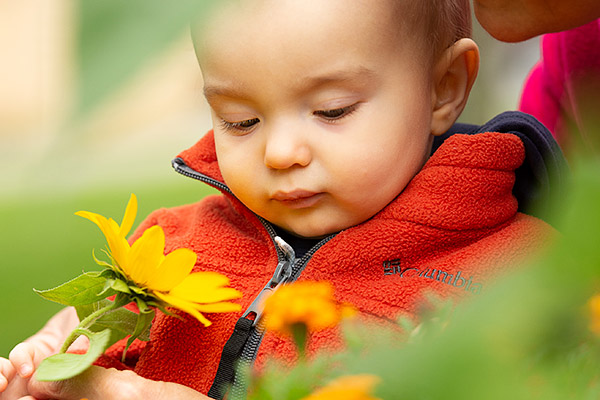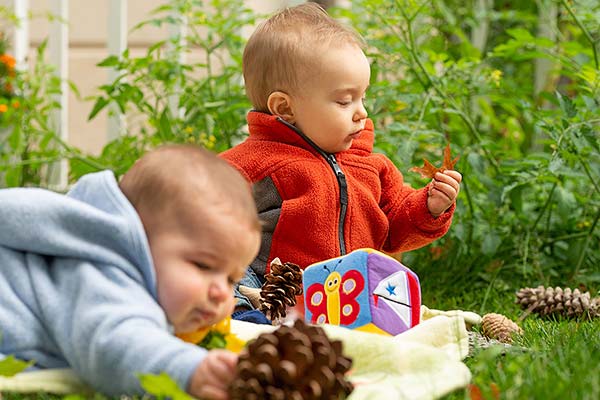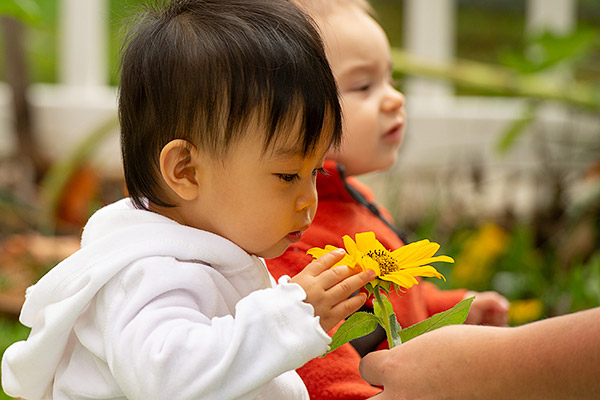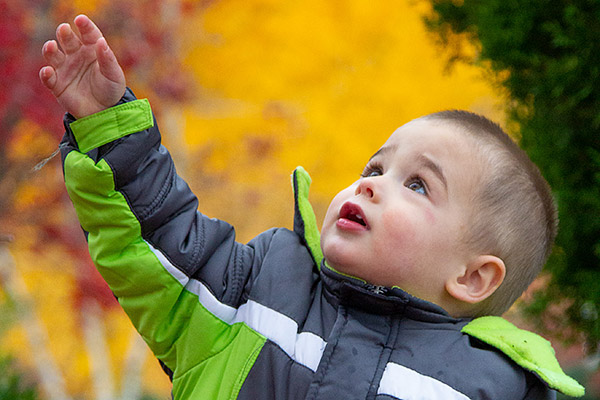Infants plus nature
The perfect equation for joyful learning
| August 2020The natural world, brimming with rich sensory inputs and delicate details, creates a powerful learning environment for even the youngest children. Picture the first time a baby feels the lush carpet of grass, or the startled and alert look of an infant after hearing the loud call of a blue jay. The combination of a child’s "wonder-filled firsts" and the natural world create a magical place for connecting and learning.

Those of us who work with this age group know that babies plus nature equals joyful learning. However, we tend to keep this age group indoors all too often. We worry that the weather isn’t quite right or the infant is too hungry or tired. We wonder if the time it takes to get ready to go outside really is worth it. The answer is “yes,” it is absolutely worth it. There are lasting benefits for both teachers and children.
Babies are natural investigators. Fuelled by curiosity, they use their senses to learn about the world. With brains wired to notice and categorise details, they want to see, hear, feel, and taste – first-hand. Allison Gopnik (1998) refers to this as “lantern consciousness, a vivid panoramic illumination of what is everyday.” Take a group of infants outdoors and you can almost see the metaphorical “lights go on”. They become focused, yet calm, primed for learning and connection.
Consider the example of nine-month-old Jackson’s investigation during a light California rain. Jackson notices a few tiny puddles on the deck in front of him, his hands splash through the puddles as he lowers one hand, then the other. Jackson notices he can make a splash. He is learning about cause and effect while exploring properties of weather.
Ellen Veseleck, Dana Miller, and Lisa Cain-Chang (2015) found that infants and toddlers develop a full range of skills in outdoor classrooms. Some of these skills are unique to being outdoors; children would otherwise be deprived of these experiences if they do not spend significant time in well planned, nature rich environments.
Some might wonder, what these babies are doing to develop such skills? Here are a few examples, as seen and recorded in programs across the country.
Eat and sleep al fresco
Fresh air and the rhythmic sounds of nature are relaxing. Nature’s role as a soother is time-tested; for generations, caregivers have been taking young ones outdoors to help them calm down and settle to sleep.
- Take children outdoors. Do it every day if possible. This doesn’t have to be an elaborate field trip; simply escape into the backyard, nearby park, or garden.
- Observe how a baby relaxes with nature. Try bottle-feeding or napping outdoors.
- Include edible herbs in your gardens. Allow the children to smell, taste, and feel their unique qualities.

Infants explore and discover the world with all their senses
Get to know each other
Infant teachers who work in Nature Explore Classrooms describe their time outdoors as an opportunity to slow down and connect more fully with individual children. It allows place and time for careful observation and noticing of what really interests each child. Consider how this four-month old, Hannah, and her teacher/caregiver interact:
Hannah’s caregiver sings as they sway in the wind on their way to the Nature Explore Classroom. Hannah notices a tuft of prairie grass and focuses on it for more than a minute before gazing back at her caregiver. Hannah’s caregiver describes the way the grass moves in the wind. Thus begins a back and forth exchange using words, sounds, and movement (Dimensions Educational Research Foundation 2011).
Nature is a natural provocateur. With its ever-changing qualities and gentle details, conversations come easier. There is more to observe and discuss.
- Talk to your babies about what you see, hear, and notice in nature.
- Build a nature-rich vocabulary and a foundation for social exchange. Incorporate seasonal natural materials – gourds, sturdy wood or shells, edible plants, varied ground cover – into your play with babies.
- Let children experience all types of weather. Be prepared with appropriate clothing for both children and adults.

Being out in nature brings wonderful opportunities to connect with individual children
Remember what it is like to be amazed
Make a choice to get outside with infants and toddlers. Give them the gift of time; time to investigate and to explore. Perhaps a baby will look to the sky, mouth open, and for the first time tastes the tingle of a new snowflake on his tongue. Then you can whisper the word “snow” and know that they are learning from this glorious natural world.

References
Dimensions Educational Research Foundation. 2011. Growing with Nature: Supporting Whole-Child Learning in Outdoor Classrooms.
Gopnik, A. 2009. The Philosophical Baby: What Children's Minds Tell Us About Truth, Love, and the Meaning of Life. New York: Farrar, Strauss, and Giroux
Veselack E., D. L. Miller, and L. Cain-Chang. 2015. Raindrops on Noses and Toes in the Dirt: Infants and Toddlers in the Outdoor Classroom. Accessed 2016 at: dimensionsfoundation.org/findings






